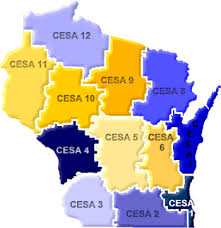Ed Tech Data Summary
The Wisconsin Digital Learning Plan (c2016) provides school districts strategies for making learning more meaningful and relevant for students, more accessible for economically disadvantaged students, and more cost-effective upon implementation. The focus, throughout the Plan, continues to be learning environments that are equitable, personalized, applied, and engaging.
DPI is pleased to present the 2021 digital learning data (2020-21 school year) for K-12 schools in Wisconsin! DPI asked questions covering all five gears of the Digital Learning Plan. This website depicts the results of those questions, which represent a cross-section of the overall data and can be used to support data-driven instructional leadership and planning. DPI has compiled the survey responses from over 94% of Wisconsin school districts (across all 12 CESA regions).
The goal of DPI and this survey is to create a collection of longitudinal data to help inform key stakeholders including individual school districts, Cooperative Education Service Agencies (CESAs), professional organizations, the Wisconsin Legislature, and citizens of the state.
The survey data has been broken down into three ways for comparison -- results at the state-level, results by district size, and results by CESA. Each section (subsequent page) includes graphs for the given data and a brief interpretation of each. A PDF copy of the entire data set for each category can be found at the bottom of each web page. You can also access data from previous years in the menu on the left of the page.
***Data from the 2020-2021 survey contains information provided by districts during a year that included COVID-19. The data from this survey may be affected by this event, but is still very valuable to use while analyzing local district planning and programming. Many Wisconsin districts have modified the learning experience in their schools and that shift may be reflected in the survey data provided during this year.
Some key findings:
- 98% of Wisconsin districts report using Google for Education in their schools for collaboration and productivity.
- Districts use a wide variety of digital learning tools and resources. Most categories for the 2020-21 school year have stayed the same since the previous year, but digital learning tools almost doubled.
- Virtual Learning Time (VLT) has increased in use over last year. During the 2019-20 school year, 66 districts (about 16% overall) had a VLT plan in place. In the current school year (202-21), 229 Districts (about 55%) have a VLT plan in place.
- 66% of school districts in the state are leveraging the Universal Design for Learning (UDL) principles in instructional practices.
- 96% of districts reported they are currently using some form of virtual, digital learning (fully virtual, online/blended/hybrid) for their educational experiences.
- 84% of districts say they offer at least one blended/hybrid class for students.
- 96% of districts say they utilize a digital classroom platform or learning management system for learning in their schools.
DPI emphasizes that the data shown on these pages captures only a single point in time. As we gather data annually, we will have the ability to chart our progress over time.
